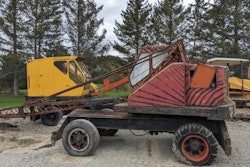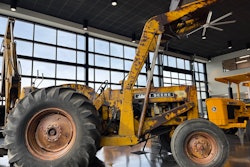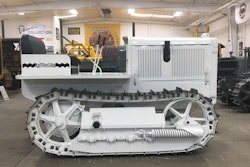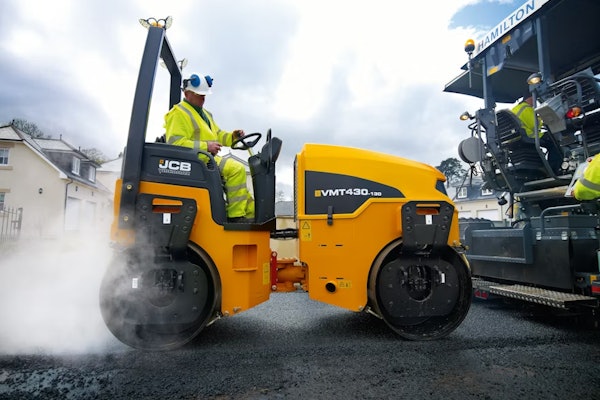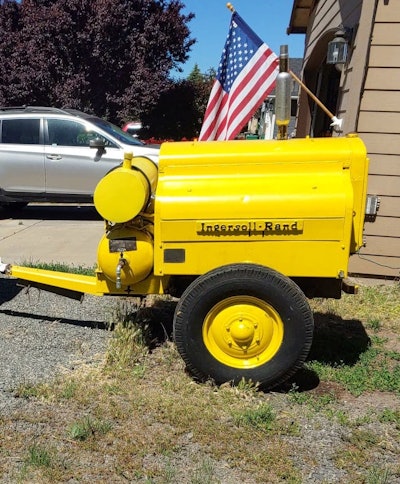
Harold Dotts and the Ingersoll-Rand air compressor he would one day own both served in the military during World War II.
Dotts was in the Navy until 1948 when he went back to work as a civilian boilermaker.
The 1943 Model D-60 two-stage air compressor was owned by the U.S. Army Corps of Engineers until the 1960s when it was sold as military surplus.
In need of a more powerful machine for his air tools, Dotts traveled to California from Grants Pass, Oregon, to buy an air compressor at a military surplus sale.
The Ingersoll-Rand compressor caught his eye. It powered his tools until he retired in the late-1970s and was later used by his eldest son, also a boilermaker.
Over time, it was lost from the family, but then it was found and restored by Dotts’ grandson Mark. He recently saved it again after it was about to be sold for scrap.
Today, thanks to Mark Dotts, the 79-year-old compressor is still running. But getting it in shape the second time was a difficult project that kept him busy for seven months. (To watch him run it, check out the video at the end of this story.)
Saved from the scrapper’s torch
Harold Dotts, known later in life as “Pop,” sold his boiler repair business to his oldest son, Harold “Porky” Dotts Jr., in the late 1970s.
Mark worked some for his uncle who sold the business but kept the air compressor. It sat for a while and then went to another relative. It exchanged hands after that, and the family lost touch.
Then one day about 20 years ago, Mark was driving and saw an old air compressor in a field. It’s yellow paint was peeling off, exposing its original Army olive drab. He stopped and talked to the owner.
“I think this belonged to my grandfather,” Mark said.
“I asked him if I could examine it.
“And I looked at it, and there were certain things I remembered about it, one of which was the compressor had been separated from the engine at one time, and then when they reassembled it, they used clear silicone. … It just stuck in my memory.”
Mark offered the man $50, and he and his father, David Dotts, brought it home and began an extensive overhaul. After getting it back in running shape, though, it sat again.
“My grandfather's rule was fire it up once a month,” Mark recalls.
But with the family no longer in the boiler repair business, there was not much reason to run it. Then his father passed away in 2014, and Mark had moved to Klamath Falls, Oregon, about 100 miles away.
In December 2021, Mark retired from the Air National Guard where he worked in the engine shop. He learned that if something wasn’t done with the air compressor, it would be sold for scrap.
“I wanted to save it from the scrapper’s torch,” he says.
Seven-month project
 The 1943 Ingersoll-Rand air compressor before being restoredMark Dotts
The 1943 Ingersoll-Rand air compressor before being restoredMark Dotts
The wheel bearings on its trailer were stuck fast. “I had to use a bearing puller to remove them off the axle,” he says. “The axle grease was like the consistency of saltwater taffy.”
He eventually got it roadworthy and hauled it home. There, he painted it yellow so as not to cause the neighbors to complain about its appearance.
The gasoline engine, a 4-cylinder Waukesha FC, needed a new exhaust intake manifold. He knew where a similar engine might be located to get the part. Only problem was, the last time he had seen it was 20 years ago when he first restored the compressor with his dad.
“So I went to that place,” he says. “It was an old logging outfit. I got permission to go where I thought it was, and sure enough, it was there.”
It was connected to a pump on a trailer. There was also another older Waukesha engine with a Delco 32-volt generator. He bought the combined package for $200. (The 1920’s era generator will be his next restoration project.)
After he replaced the engine’s exhaust intake manifold, he needed a new exhaust pipe because the cast-iron one was cracked. He went to a muffler shop to have one made. “It never had a muffler,” he says. “It was just louder than hell.”
 The air compressor's restored model name plateMark Dotts
The air compressor's restored model name plateMark Dotts
“I had to make a tool to begin the process of unsticking the seized pistons,” he says. “I was lucky enough to not break any of the piston rings, because I have no idea where on earth am I going to get these parts.”
The engine head bolts also needed to be replaced. He did some research and learned that the Ford Model A’s of the era used Grade 5 studs. “So I ended up making studs,” he says. “I would take a Grade 5 bolt, chuck it up on my lathe and machine down the head for the taper. I made 18 studs from Grade 5 bolts.”
The drain plug on the engine was pointed downward instead of to the side. He fixed that and also made a new aluminum gas tank out of 12-inch irrigation pipe.
He discovered some worn-out ID tags on the compressor. One had the cranking instructions and another had the ignition timing instructions. He restored them as best he could, but some of the wording had worn away.
He also saw that rust had gotten into the starter. He went off to a junkyard to look for another one. He also had to overhaul the compressor’s regulator valve.
“That was one of the last things I had to unstick,” he says.
Still runs after all these years
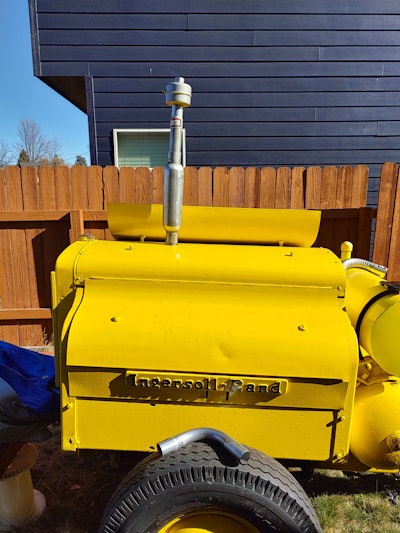 The 79-year-old air compressor still runs.Mark Dotts
The 79-year-old air compressor still runs.Mark Dotts
Now it was time to crank it up. His uncle had taught him how to run it. Mark had been working with him on a boiler repair job at a high school when he learned.
He recalls how the machine would run hard for the boiler repair business. “When my uncle had it, he would just dog that thing,” he says.
It can run at up to 125 pounds per square inch of pressure and has quick recovery. Mark set it at 100 psi.
It can be started by crank or by electric starter.
Mark got it running.
“I was impressed with how it still functions pretty good,” he says.
“But the nice thing about is,” he adds, “it's not just to fire it up and go ‘ooh, ahh.’ You can actually use it to run your air tools.”
Mark also sees it as preserving the historic past. He’s found little information about the compressor through online searches. Attempts to find out information from Ingersoll-Rand didn’t turn up any details on the 1943 compressor model. He has not been able to find any technical data or manuals on it.
“I've spent hours gleaning the internet for information, and I've only found one source,” he says. “And he was doing the same thing, looking for information.”
Along with preserving his grandfather’s legacy, Mark hopes to preserve the forgotten piece of history for future generations.
“I'd like for it to be saved as an example,” he says. “Based on so few of them out there, if there are any left, I think it has historical value.”
“I don't really feel like I own it,” he adds. “I just feel like I'm taking care of it.”
To watch Mark Dotts run his restored 1943 Ingersoll-Rand Model D-60 air compressor, check out this video he submitted:





